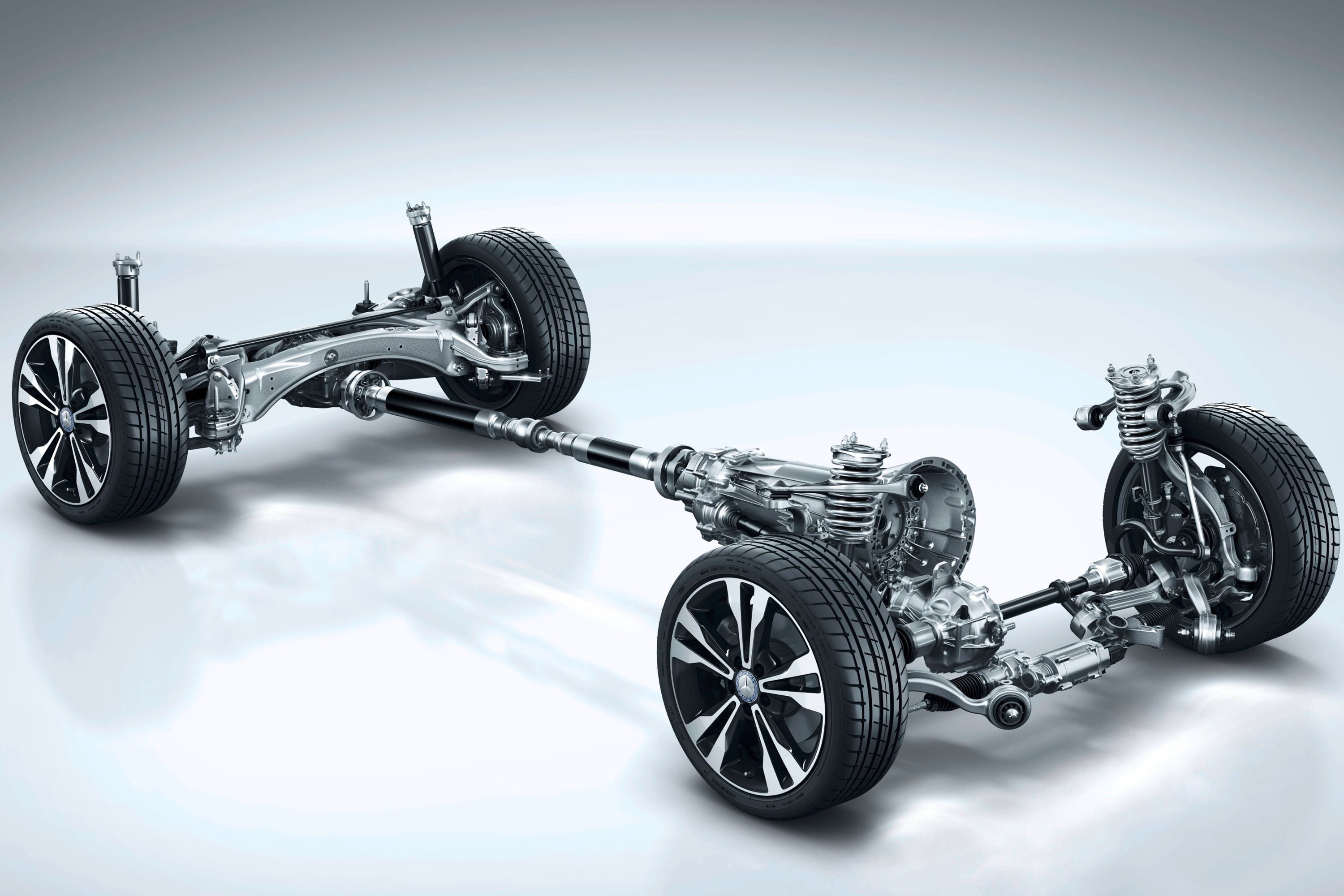As someone reading an article like this, you likely already have an inclination of what a driveshaft is, but the term 'driveshaft' is often misused in 2021. In most instances, what people are talking about is actually the propshaft, and there are variations including the one-piece driveshaft, but this specific type is not common besides in sports cars.
Regardless, the location is the same and it commonly sits in the center of the transmission tunnel. The propshaft is the propeller shaft or the rotating shaft that extends from the gearbox to the differential, powering it and thus the wheels. The sideshafts or drive axles coming out of the differential at the rear of an all-wheel drive (AWD), four-wheel drive (4WD), or rear-wheel drive (RWD) car, or the half-shafts (also known as drive axles) coming out of the gearbox and connecting to the wheels on an FWD car, are actually the driveshafts, but common use has seen the terms propshaft and driveshaft used interchangeably as terms.
Thus, the propeller shaft or driveshaft is ultimately the rotating rod that transfers power from the engine and gearbox to turning motion on the wheels, via other components including the sideshafts and differentials.
Types of Driveshafts and Layouts
- Front-mounted engine and transmission with RWD: the driveshaft comes out of the gearbox and is connected to the differential, which is then connected to CV joints via sideshafts, and powers the wheels.
- Front-mounted engine and transmission with AWD/4WD: same layout as RWD, with the front wheels powered directly by the gearbox or in some cases, another differential. However, in the latter instance, there is also a transfer case that sits on the gearbox and this has a secondary front driveshaft.
- Front-mounted engine and transmission with FWD: typically of unequal length, these sideshafts are sometimes called half-shafts, and their proximity to the driven wheels negates the need for a typical propshaft. Nevertheless, their job remains the same: to power the wheels. All cars have sideshafts, but not all have a propshaft.
- Rear-mounted and mid-mounted engines: these have the same sort of setup as other RWD and AWD vehicles, but with the gearbox and differential typically mounted ahead of the engine for better weight distribution. The driveshaft here is typically very short, but it can vary depending on where the gearbox and differential are in relation to each other and the engine.
How Long Does a Driveshaft Last?
A driveshaft can last the life of the car if it has not been excessively strained, so remember to drive your new crossover with care. With regular cleaning and lubrication (say twice a year), normal driving won't damage the driveshafts. Most don't actually perform any maintenance on this component as failures are not common.
However, driveshafts do wear out, and various factors can affect this. Worn bearings, CV joints, bushings, and even wheels can prematurely deteriorate the condition of your sideshafts, but bad driving practices and bad luck (for example, large unseen obstacles) can affect you too, with all of these having a knock-on effect on the driveshaft if you're not smart about addressing them. For example:
- If an off-roader gets its wheels stuck but the driver keeps trying to force them to move, the driveshaft can twist and/or break.
- The same can happen by pushing too much sudden force through the drivetrain when launching a high-powered car with loads of traction; weak driveshafts can see these components break. This is why some supercars now have carbon fiber driveshafts, lessening their inertia and increasing their resilience.
Ultimately, the typical cause for a driveshaft failure is excessive torque, but as a solid unit, it is usually the bushings, joints, and couplings that fail first.
What a Bad Driveshaft Noise Sound Like and How to Tell if a Driveshaft is Bad
So, what does a bad driveshaft sound like? Well, this varies greatly depending on the issue. Multiple factors can be the cause of a damaged driveshaft, and as this is the case, different sounds can emanate from the drivetrain. Whatever the symptom, this short list should alert you to a broken driveshaft and help with troubleshooting:
Rattles
A broken or damaged driveshaft will typically cause a bad vibration and rattling when you're on the gas. In extreme cases, a bad driveshaft vibration will be present even when you're coasting, but the noise and vibrations can often be detectable even through the seat.
Squeaks
A damaged coupling or bad driveshaft bearing can cause this noise, but this symptom is rare. However, if it does arise, your problem could also be attributed to a loose universal joint (U-joint).
Clunks and other harsh noises
This is the most common symptom of a damaged driveshaft. You'll notice a knock when you pull away from a standstill, and sometimes even as you change gears. Changing to reverse gear can also result in a knocking thud if the driveshaft is damaged. A broken U-joint can again be the issue, but loose fasteners can also be at fault.
Uneven acceleration
If your vehicle isn't performing as it usually does and feels like there is more resistance than usual to get the car going, the driveshaft could be at fault. The vehicle may struggle to transmit power to the rear wheels, and this can feel like a slipping clutch. If these symptoms of a bad driveshaft are present, then the driveshaft is likely beyond repair and may need a full replacement.
Can You Drive Despite the Symptoms of a Bad Driveshaft?
Obviously, if it has failed completely, there will be a complete disconnection of the drive and your car simply won't move, or it will come to a standstill if you're driving it. The engine will run, but the wheels won't turn, despite being in gear. Often, this might be accompanied by noises coming from underneath the vehicle, as only a part of the driveshaft assembly is still spinning up to the point of the failure. However, this rarely happens and there is usually ample time to correct the problem once you first hear a symptom arise. In case of any of the above symptoms, have the car looked at without delay. You might be able to drive with it for a while, but the problems will get worse and the vibrations may cause additional parts to fail if left unattended. If you suspect that it is damaged, it is best to get the driveshaft dropped and inspected. A driveshaft that fails catastrophically while driving can seriously damage your car, especially if it detaches from the vehicle.
Keep in mind that not every noise that emanates from underneath your car comes from the driveshaft. CV joints can also make clicking noises when they are failing and the transmission, wheel bearings, hubs, brakes, and other components can exhibit many a symptom and make strange noises too. If you are unsure of what it is that's causing the noises you hear, have it looked at as soon as you can, before there is a knock-on effect and more things fail. A professional is best suited to help you figure out how to tell if a driveshaft is bad enough to stop driving immediately, but a good place to start when you first suspect something is amiss is to consider the symptoms listed in this article. They cover most of the typical tell-tale signs of a bad driveshaft. Knowing what to expect will provide you with enough information to decide whether you should rather have the vehicle towed than continue driving. Review the situation and your options carefully, but always err on the side of caution if you're unsure.
When Should You Replace a Driveshaft?
Most professional inspections will reveal failed components even if you yourself don't know about them. You will usually be able to continue on your way after the offending U-joint or carrier bearing has been replaced, with the driveshaft itself typically undamaged. The removal and replacement of the entire driveshaft is almost never necessary unless it has become damaged in such a way that it is bent or twisted, or its integrity has been otherwise compromised in some way. However, failures are exceedingly rare, such that most cars sold in the US today run on the same driveshaft for decades.
How Expensive is it to Replace a Driveshaft?
To replace an entire driveshaft can be expensive, costing thousands of dollars on premium or specialist off-road vehicles. In some cases, the parts are not actually that expensive in the US, but the cost of labor must still be factored in with the price of parts. Thankfully, many symptomatic problems can be sorted out by replacing bad driveshaft bearings and U-joints at a lower cost, and those with a little mechanical inclination can usually DIY the job, but it is important to remember that an unbalanced or poorly installed driveshaft will cause more problems very quickly. This is why you may get bad driveshaft symptoms despite a new U-joint should the latter fail and be replaced. This is why we recommend using professionals for jobs like these, as balancing a propshaft is a job that can't be reliably carried out in your backyard.
Conclusion
The driveshaft, or propeller shaft as it is more accurately named, is a hardy and resilient component of your car's drivetrain, but that does not mean that it does not require care. As with any mechanical component, repetitive bad driving practices can cause the driveshaft to suffer abuse that may leave you immobile. Furthermore, as with most other car components, failure to maintain the surrounding systems of which the driveshaft is a part can result in premature wear or damage. Once again, our advice is to inspect all components of your vehicle regularly, preferably each time you service the car, and lubricate or grease any moving parts that may seem sticky or dry. This does not have to be a comprehensive evaluation of the car's health, but keeping an eye and an ear open for signs of trouble and regularly giving major components a cursory inspection can save you countless dollars in the long run. For more guidance on car maintenance, be sure to check out our blog post here.


